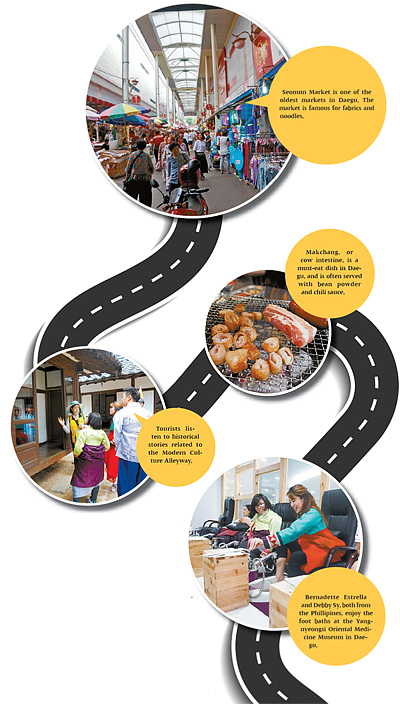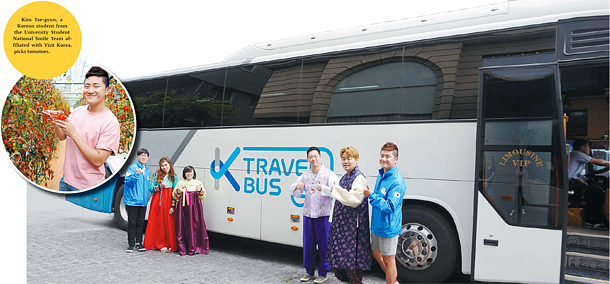K-Travel Bus service gets foreign tourists out of Seoul

To celebrate “Visit Korea Year” along with the 2018 Pyeongchang Olympics, the Visit Korea Committee has launched K-Travel Bus, an overnight shuttle tour for foreigners only. The committee hopes the inter-city tours not only will revitalize the regional economy, but it hopes to spur repeat visitors by foreigners to Korea.
Few foreign tourists are familiar with the various attractions outside of Seoul. Thus, the committee, with the goal to attract more than 20 million foreign tourists, has prepared six regional bus tours: Daegu; Pyeongchang and Gangneung in Gangwon; the Damyang and Yeosu area in eastern South Jeolla; Yeongju and Mungyeong in North Gyeongsang; Busan and Ulsan; Jecheon, North Chungcheong and Muju, North Jeolla.
Bernadette Estrella and Debby Sy, both from the Philippines, have never been anywhere in Korea other than Seoul and to their school, Far East University, in North Chungcheong.
“Even though it is my third year in Korea for my master’s degree, I lacked the chance to go to other regions,” Estrella, 23, said.
On Wednesday morning, with four foreigners aboard, the K-Travel Bus headed for Daegu. Two Korean students from the University Student National Smile Team, which is affiliated with the Committee, joined the tour to help the tourists navigate unfamiliar territory.
Buses are used to allow foreigners to go deeper into the region as traveling by train often introduces a language barrier.
“There are a lot of inconveniences for foreigners to travel by train. I have to check the schedule from one to 10 and if I miss something then I have to ask for help. It’s difficult to find a proper person to guide me,” Sy, 20, said.
Sy heard about K-Travel Bus from a friend who saw the tour group’s Facebook page. She thought it was the perfect opportunity to look around Korea.
K-Travel Bus started on March 25, but has yet to catch on.
“This is the third month since K-Travel Bus was launched and operated. At this moment, there aren’t many users,” Yoon Kyung-min, an assistant manager of Visit Korea said. “If tourists are planning to come to the latter half of the year, that will be the real beginning of K-Travel Bus.”
Early on the morning of the tour, foreign tourists and Korean college students gathered in Gwanghwamun, central Seoul.
English-speaking tour guides join the tour but guides speaking other languages tag along, if needed.
For this trip, tour guide Jung Hee-won, hopped on the bus to give an English narration around Daegu.
“I spent two years of my military service here in Daegu,” Jung began his introduction. “Daegu has been an important place tactically especially during the Korean War because it was the central place to get right to Seoul.”
His introduction of Daegu and historical information of Korea gave the foreigners insight about the places in Daegu on the tour.
The overnight itinerary for the Daegu tripincludes Seomun Market, Modern Culture Alleyway, Yangnyeongsi Oriental Medicine Museum, Kim Kwang-seok Road and Apsan Observatory night view on the first day. On the second day, hiking and tomato picking are planned.
“I had barely no background information about Daegu, except that the place is extremely hot in summer,” Jin Yongri, 25, from Jilin province in China, said during a tour. “I am excited that we are going to Seomun Market in particular. Looking around the traditional market is the quickest way to know the region.”
At the Modern Culture Alleyway and Yangnyeongsi Oriental Medicine Museum, the tour group had an opportunity to wear hanbok, the Korean traditional costume, as they toured the historical sites.
“I heard that borrowing hanbok for an hour costs around 15,000 won [$13],” Estrella said. “But I could enjoy the experience and take a lot of pictures with my friends for free. When I was walking by, an old lady told me I looked pretty.”
The participants seemed to enjoy the foot bathing in the museum most. For 20 minutes, they soothed their feet after a series of hectic tours. Ten types of traditional medicinal herbs were used in the bath water.
“I like experiences that are rarely available outside Korea,” Jin said.
In Daegu, known for makchang, or cow intestine, the group decided to give the delicacy a try.
“I never tasted makchang before, but it was very delicious,” Sy said. “The Korean students told me how to eat this with the special sauces, bean powder and chili sauce.”
On the second day, the group’s first stop was the Gatbawi in Palgong Mountain, a famous place for Buddhists who go there to pray. The statue of the Buddha was made of rock in the Unified Silla period [676-935] and has been designated as the National Treasure No. 431.
The tracking took more than 30 minutes. Even though the group was tired from the previous day, they soldiered on.
After having samgyeopsal, or pork belly, for lunch, the participants went to pick tomatoes.
Estrella and Sy enjoyed the bus ride and talked about the ease of meeting new people on the tour.
“I think the whole schedule is well organized along with enough rest. There are many photos to upload to my Instagram,” Sy said.
Yet the tourists noted that there was some room for improvement on the itineraries.
Foreigners on the tour thought they should be tweaked for a foreign crowd. For example, most on the tour didn’t understand the cultural significance of Kim Kwang-seok road in Daegu, where they stopped. But Kim was a renowned singer and songwriter who recorded numerous songs in the 1980s. Many Koreans sympathized with the lyrics he wrote and many singers have been remaking his songs in various versions even today.
However, although the participants did not know the singer in advance, they took photos.
“I think that this is a must-go for Koreans who visit Daegu, but for us foreigners, there is not much connection with the singer,” Kim Kouk-jou from Paris said.
In addition, Kim added that the tour would have been much exciting if it had more activities.
“I’d suggest that there would be a little more activities rather than the perfunctory sightseeing,” Kim said. “Nevertheless, I think the idea of the K-Travel Bus is good for foreigners who are new to Korea,” he said.
The Korean students on the University Student National Smile Team said the tour was valuable to spend time with foreign friends.
“As a student learning Hospitality Tourism Management at Sejong University, I always had questions about how the foreigners view Korea,” Lee Seung-chan said. “Through this trip it was enjoyable to discuss Korean culture with foreign friends. I learned that they have great interest in diverse regions outside of Seoul.”
Kim Tae-gyun, another member of the team, also joined the K-Travel Bus tour.
“What I liked about K-Travel Bus is that the trip does not force the tourists to go shopping,” Kim Tae-gyun said. “Also besides the appointed schedules, there was a lot of leisure time, so I’d definitely recommend it to my foreign friends.”
To use the K-Travel Bus, go to the official website, www.k-travelbus.com where there are six options available with detailed itineraries. Reservations can be made directly online with various payments.
Bus tours run every week if there are more than four participants. The price varies according to the destination and age. Tours range from $145 to $170 per person. Transportation and accommodation fees are included in the cost, as well as the tour guide and program fees. However, the fees for food, except breakfast at the hotel, are excluded.
“Foods are excluded because there are foreigners who have differing tastes,” Yoon explained. “Also, some might have certain food allergies and some might be vegetarians. Moreover, in the traditional markets, they might want to taste all different kinds of foods, so free time is given.”
The bus has free WiFi so that riders can easily access the Internet.
The itinerary can change according to the seasons, for example. This month, in Daegu, the Chimac Festival is planned for July 27 to 31.
Chimac is composed of two words: chicken and macju, which means beer, one of the most popular late-night Korean snacks. As part of a promotion, if foreign visitors make reservation for the July 29 to 30 trip to Daegu, joining the festival is free. Chicken and beer are free as well and tourists will receive a 30 percent discount off the cost of the overnight trip.

K-Travel Bus takes foreigners on overnight tours around regions outside Seoul such as Daegu, South Jeolla and North Gyeongsang among others.[VISIT KOREA COMMITTEE]










with the Korea JoongAng Daily
To write comments, please log in to one of the accounts.
Standards Board Policy (0/250자)